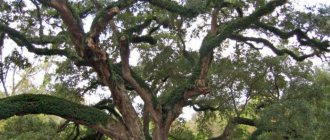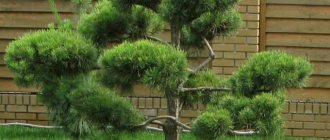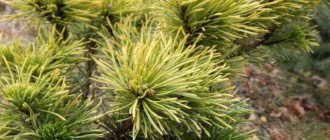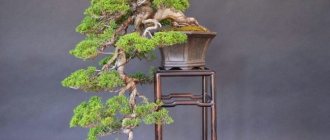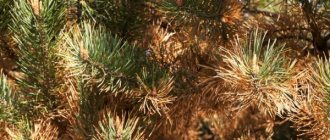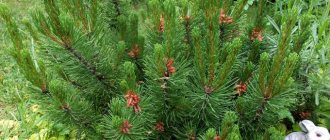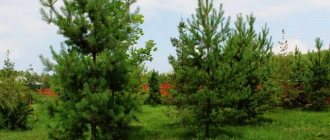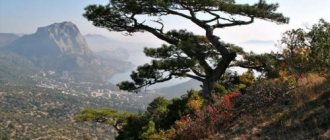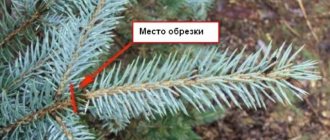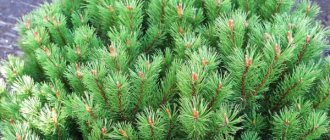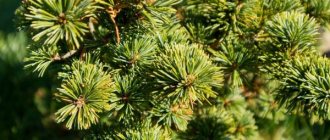Pine: procurement of medicinal raw materials
For medicinal purposes, pine buds and needles (branches and cones) and products made from pine are used: turpentine, tar, rosin and wood vinegar, as well as natural pine resin (“grains”).
Pine buds are harvested in early spring. Photo: FitoHome.ru
Pine buds are cut with a knife along with the crown (four to five shoots) in early spring, when they are just beginning to swell and while the covering scales are still tightly pressed to the bud. Pine buds are the ends of young spring leaf-bearing shoots. Pine buds are dried outdoors under a canopy, in an open attic or in well-ventilated areas.
Needles (branches and cones), also containing essential oil, are collected at any time of the year.
Resin is collected from trees, in places where it accumulates between the bark and wood of thick roots, and is also released on the affected areas of the trunk.
Medicinal properties of Scots pine
Pine buds contain resin, essential oil (turpentine), starch, bitter and tannin substances, mineral salts and vitamin C, which gives the preparations strong medicinal properties.
Pine buds are used in the form of a decoction (10.0–200.0):
- as an expectorant (for bronchitis),
- as a diuretic and disinfectant (infusion or turpentine),
- for inhalation (inhalation) for inflammation of the upper respiratory tract,
- for treatment with baths (in the form of a decoction or infusion),
- with rickets and scrofula.
Preparations from pine buds
To prepare the mixture at home, you need to pour 50 grams of pine buds with 2 cups of boiling water, leave for 2 hours in a warm place, strain. To improve the taste, add 500 grams of sugar to the infusion and boil until syrup is obtained. You can add 50 grams of honey to the strained syrup. Drink the mixture one spoon a day.
Pine honey is a jam made from pine buds that has a whitish-golden color and a pleasant pine aroma. Along with other medicinal properties, jam is useful for inflammation of the upper respiratory tract.
Pine needle extract (pine needle decoction) is used in the form of baths for rickets and gout .
For rheumatism, neuralgia and gout, rub turpentine. Turpentine can be inhaled in the same way as an infusion from the kidneys (for putrefactive bronchitis).
Recipe for a vitamin drink from pine needles : pine needles - 200 g, water - 1100 ml, sugar - 40 g, aromatic essence - 7 g, citric acid - 5 g. Rinse fresh pine needles in cold water and place in boiling water. Cook for 40 minutes, covered. Add sugar, aromatic essence and citric acid to the broth. Cool and strain the drink. Store in the refrigerator for no more than 10 hours.
Pine wool is used for pain-relieving dressings for rheumatism and gout. At home, pine wool can be replaced with heavily crushed pine needles, sifted and mixed with ordinary pharmaceutical cotton wool.
For female diseases (bleeding, fibroids), Scots pine needles are taken orally in the form of a decoction or infusion of cones for scurvy. These same drugs are taken for scurvy.
Pine resin (resin) is a good expectorant - turpentine contained inside the tree and hardened when released as a result of oxidation and drying. The grains, or “grains,” of the resin are swallowed (one grain per dose, 2 times a day).
Pharmaceutical pure tar is a product of dry distillation of pine (or birch) trunks and branches. Tar has a disinfectant, antiparasitic effect, therefore it is used externally for the treatment of skin diseases (eczema, scaly lichen, scabies) in the form of 10-30% ointments, liniments, sulfur-tar soap and other complex preparations.
Directions for use:
- Decoction or infusion of pine buds: 2 tablespoons 3 times a day.
- Decoction or infusion of pine needles: 2 tablespoons 3 times a day.
- Pine needles for baths: 50 grams of buds or pine needles per bucket of water.
Literary source: A.P. Popov. Medicinal plants in folk medicine, 1960
Pine: contraindications
- Preparations from pine needles, buds, and pine cones are contraindicated in case of kidney disease (glomerulonephritis) or pregnancy.
- You should refrain from treating hepatitis during an exacerbation.
- Excessive intake of coniferous preparations leads to inflammation of the mucous membrane of the gastrointestinal tract, kidney parenchyma, headache and general malaise.
- Turpentine and preparations based on it are contraindicated for nephritis and nephrosis.
- Hypotonic patients and people suffering from thrombosis should take coniferous drugs with caution.
- In case of heart failure, you should limit walking in pine trees - pine phytoncides, especially in spring, aggravate angina pectoris and can cause a heart attack.
Preparing for landing
The desire to quickly plant a nice specimen of pine in a ceremonial place in the garden is natural and easy to achieve: I dug a small hole and planted it. Pines only need a sunny place, and they are undemanding about soil conditions and grow well on loam, black soil and sandy loam soils. The general rules for planting are set out in the “Gardener’s Cheat Sheet,” but what to do with a seedling when a planting site has not been chosen or the site has very heavy clay soil? I don't have problems with free space, but I do have difficulty deciding on placement in compositions. To give myself time to think and not torment the plant with transplants, I practice planting “newbies” in a temporary place in “mesh pits”. This idea is borrowed from the experience of nurseries that specialize in growing large plants. I choose a place for the “school” in an area that is well lit throughout the day, close to the path, so that it is more convenient to control the condition of the seedling. I dig a hole twice the size of the container. The shape of the pit is a truncated cone with flat walls. I line the cavity of the planting pit with a strong plastic mesh with a mesh size of 1.5–3 cm; it is important to avoid wrinkles on the mesh and carefully straighten it. Then I cover the mesh with a mixture of garden soil and sand (2:1) in a layer of about 10 cm and water it with a hose. Separately, I prepare a substrate for backfilling from my loose garden soil and sand (5:1) with the addition of a glass of wood ash. Before planting, I soak the seedling in a root formation stimulator, and then carefully use a large screwdriver to straighten the roots along the periphery of the root ball. I plant the plant so that the root collar is 3–5 cm above ground level. The edges of the mesh can either be left on the surface, or covered with earth by first inserting beacon sticks along the diameter. When planting, it is necessary to water in several stages using a watering can with a diffuser, since soil compaction prevents the development of roots. I mulch the plants in the “school” with a mixture of compost, sand and pine litter. This composition is suitable for fairly frequent loosening after watering. When planting in hot weather or in mid-autumn, I install a “wigwam” or “yurt” made of sticks or arches, and use covering material with a density of 17–30 g per square meter. I water the plants in the “school” approximately once every ten days from a watering can, combined with treatment with root formation stimulants (twice a month). In general, it is better to water pine trees rarely, but abundantly, and morning sprinkling is a very useful procedure, which you should try to do more often during the “dusty” summer period. While the mountain pine is taking root in the “school,” it is advisable to decide on a permanent location and prepare a planting hole so that the soil in it settles. The optimal time for transplantation is early September, when cool weather sets in. The operation of relocating a pine tree to permanent residence should be carried out quickly to avoid drying out the young roots. When replanting, the mesh will avoid damage to the roots and prevent the root ball from crumbling. If it is not possible to separate the mesh, it can be cut in several places. When planting, it will not be superfluous to take into account the location of the pine tree relative to the cardinal directions; you can tie a “bow” on the south side in advance and plant it as the plant is “used to”. If you miss this moment, the pine may burn. There is no need to stand on ceremony with the purchased seedlings; they have been sufficiently “hardened” on the trading floors.
Facts about pine
- Pine has been used as a medicinal tree since ancient times. During archaeological excavations on the territory of the Sumerian kingdom, clay tablets with recipes were found indicating that 5 thousand years ago the Sumerians used pine needle extracts for compresses and poultices.
- Turpentine and its purified preparations (turpentine oil, terpine hydrate) have an antiseptic, locally irritating and distracting effect. They are used in ointments, balms and other mixtures externally for rheumatism, gout, neuralgia, and inflammatory diseases of the respiratory organs.
- To treat skin diseases, pine tar (Vishnevsky ointment) is used in various ointments.
- In modern pharmacology, pine needles are considered a valuable vitamin preparation; infusions and concentrates are prepared from it for the prevention and treatment of hypo- and vitamin deficiency, and are also used as a disinfectant, expectorant and diuretic.
- During the siege of Leningrad, the production of a vitamin drink from pine needles was established at the Forestry Academy. During the war, people were treated for scurvy with infusions of pine needles. In the post-war period, researchers at the same academy developed the production of chlorophyll-carotene paste, which is widely used as an external remedy for burns and various skin diseases, and is prescribed internally for peptic ulcers.
Benefit: medicinal properties
Due to the content of useful substances in the bark, preparations based on it have the following properties:
- help eliminate chronic fatigue;
- help improve the condition of patients with hypertension, diabetes, and also after a stroke;
- help improve memory after head injuries;
- improve heart function and strengthen blood vessels;
- help normalize blood pressure;
- strengthen tooth enamel;
- reduce bleeding gums;
- reduce cholesterol;
- Pycnogenol is included in many anti-aging creams, which promote the production of hyaluronic acid, resulting in an increase in the elasticity of the skin, improved firmness, slowed down the aging process, and smoothed out wrinkles.
Application in medicine
Traditional medicine suggests using raw materials to combat various ailments. For example, to reduce blood cholesterol levels, it is necessary to grind the dried bark to a powder state.
Take half a teaspoon of powder before meals, once a day, with water. The course of treatment is 3-4 weeks.
The powder can also be used to improve the condition of blood vessels. To do this, you need to consume half a teaspoon of the product every day, stirring it with honey or lemon juice (1 teaspoon each).
If you have a sore throat, sucking dried pine resin is effective.
If you mix pine and willow bark powder, you can get a unique remedy that has anti-inflammatory, immunomodulatory and analgesic effects.
Thanks to it, you can eliminate the painful symptoms of arthritis, arthrosis and other joint diseases. To do this, the powders are mixed in a 1 to 1 ratio and taken half or one teaspoon before meals 1 hour.
Pine bark can benefit men, because thanks to its composition you can get rid of adenoma and prostatitis, and cure impotence. If you plan to collect raw materials for preparing a “male” product, you need to do this before March 15th.
The composition includes not only pine bark - it is necessary to collect it from trees such as linden, aspen, juniper, willow, alder, fir, birch, poplar, oak, apple larch and spruce.
All ingredients should be thoroughly crushed to a powder state and take 1 part of each (except for poplar and aspen - they need 0.5 parts each), mix well. After this, 1 glass of the mixture is poured with 3 liters of water and placed on low heat, boiling for 30 minutes.
Then remove from heat and leave for 12 hours. You should definitely cover the pan. After this, the raw materials are filtered, 0.5 liters of vodka are added to it, and put in the refrigerator. Take 0.5 cups three times a day, half an hour before meals.
A forgotten craft is pine root weaving.
“A forgotten craft - pine root weaving.”
An original, one of the ancient folk crafts, weaving from pine roots originated a long time ago, either on the Arkhangelsk or on the Vyatka side, or maybe in the Komi Republic, but most importantly, along the trade routes from the Northern Dvina to the Volga.
In Vyatka, craftsmen were called charmers, after the main product, the charm, in which loaves of bread were baked; at the end of the 19th century there were more than a hundred craftsmen in the Vyatka district, their products were even sold abroad.
Vyatka charm in the photo:
In the Northern Territory, products made from roots were called korenniks, rhizomes, they were used on the farm, and they were woven only in areas where there were pine forests nearby.
Products made from pine root are environmentally friendly, strong and durable. They are suitable for permanent use as kitchen and table items. A dish, tray, basket, vase - everything is suitable for bread on the table, cookies, sweets, fruits. Exclusive and original boxes, boxes, and handmade sculptures will serve as a genuine decoration for your interior.
Strength and durability for decades are guaranteed by the original handmade technology. Over time, the wood of the product will only darken, which is not an obstacle to its use. In case of contamination, you can wash with soap and water with a soft brush or sponge, and then dry. Don't forget: this is a tree! It may break if hit hard. Things can be repaired and used for many years
. The simplicity of the craft, the absence of large devices and a small number of tools make it possible to work in residential premises, without requiring separate workshops. Material: pine, spruce root and willow twig for the base - not a problem in the taiga. Currently, weaving is practiced in the Kirov, Arkhangelsk regions and in the Komi Republic - traditions are being revived at the modern level.
More about the craft:
This craft is attractive because it easily adapts to everyday needs. What did they not weave? Dishes and interior items, furniture, carts, all kinds of fishing and hunting equipment.
The weaving technique was passed down from generation to generation, preserving the ancient traditions of the craft.
In the Russian north, along with other types of weaving, weaving from pine root was common.
Products made from root are very beautiful and durable. Making such items requires a lot of time and labor.
The roots of spruce, pine, cedar, and fir are unusually flexible. A fresh root can be easily tied in a knot without fear of breaking it. When dry, the root becomes elastic and durable, and the glossy surface of the cleaned root is unusually beautiful. Therefore, peasant craftsmen did not ignore the roots.
If high strength was required from a wicker vessel, it was woven from the roots of coniferous trees. Various utensils made from them - salt pans, grains, baskets - were called rootlets. When weaving the roots, a special weaving technique was used - spiral. Laying the thicker root - the base - in spiral turns, they successively wrapped the thin root - the braid, turn by turn.
To make various types of products, only 3 types of weaving are used: oval, round and rectangular.
Read more about them...
First, a “braid” is made, i.e. the base of the product.
To do this, a thicker root is braided in a spiral - the base with thin roots, capturing the previous row. Soak a round unlayered root of the required diameter onto the bundle at the same time as the layered root. Then comes the usual weaving.
The product is dried after each weaving procedure. To continue working, the edges are soaked again.
Pine roots are strong, elastic and flexible, and harden when dry. Pine root is durable; it is used to make products for various household purposes: baskets, bread bins, boxes, boxes, candy dishes, vases, trays and much more. The products are distinguished by strict forms and natural noble color. Even as the products darken over the years, they only benefit. In terms of production time, a small salt shaker requires 2 days, if you weave it slowly and from already prepared material. A large box will take 3-4 months.
Root weaving is common in many regions of Russia and everywhere the products have their own names: “korenushki”, “koreshatki”, “korenovatki”, “kornevatki”.
From the name it is clear from what material the products are made. The craft is also unique in that it is impossible to prepare raw materials industrially. This is always hard manual labor.
In the traditional folk environment, this craft was mainly male, since the work requires great physical strength.
You can see the whole variety of pine root products in my store. Best regards, Evgeniy.
Use in gardening
Since bark is an environmentally friendly natural material, it is often used as mulch. In a crushed state, it is also used in decoration, design of rose gardens, and areas where coniferous trees and shrubs grow. For mulching, you should use finely ground bark.
In addition, it can also be used for composting. It is necessary to put pieces up to 40 cm long in one pile, moisten them and add mineral fertilizers to them (ammonium nitrate or urea - 1 kg per 100 kg of raw materials, 2 kg of sodium nitrate and 200 grams of superphosphate).
After this, the pile is watered with manure liquid. You need to shovel the compost a couple of times a season, and after six months it will be ready for use.
Pine structure
Pine is no different in structure from other types of coniferous plants. It consists of:
- root;
- trunk;
- branches;
- pine needles
1 - general view of the tree, 2 - shortened shoot with two needles, 3 - branch with female and male strobili, 4 - female cone, consisting of macrostrobilae, at the time of flowering, 5 - macrostrobilus (a - seed scale with two ovules, b - covering and seed scales), 6 - branch with an overwintering cone (a) and a formed cone (b), 7 - opened mature cone, 8 - male spikelet consisting of macrostrobilae, 9,10 - microsporophyll, 11 - pollen, 12 - lignified seed and covering scales with a thickened apex - a scutellum (apophysis), 13 - lignified seed scales with 2 winged seeds, 14 - a seed with a wing.
The trunk is straight, slender and clean, without branches. If a tree grows in an open area, then more branches appear, and it grows worse in length and width. The bark varies in thickness along its entire length: at the bottom it is thick and hard, and the higher it is, the softer it becomes. On average, pine grows up to 40 m, but there are some species that grow up to 80 m.
Did you know? Pines clean the air well. Near a pine forest there are 70% fewer microbes than in other areas.
The crown changes its type depending on age: in youth it is cone-shaped, in old age it is umbrella-shaped and wide. The order of the branches is whorled: 5 branches are placed in a fan around the trunk. The whorls rise in floors to the very top.
Thanks to the whorls, you can find out how old the pine tree is: how many of them there are - that’s the age. The needles are arranged in pairs and are 2.5–9 cm long; the younger the tree, the longer they are. The cones are yellow or gray-brown, 2–7 cm in length.
Procurement and storage of raw materials
Only young trees have medicinal properties, so it is worth carefully examining their appearance. Procurement of raw materials includes the following stages:
- You need to find a healthy tree in the forest - its bark will have a light brown color.
- Using a knife, carefully cut the raw material from the bottom of the trunk. It is thicker at the base.
- Then the bark is thoroughly cleaned of insects and dirt. To do this, hold it under running water.
- Cut the raw materials into small pieces, place them on a tray - they should dry.
- After complete drying, grind (if necessary) the bark into powder. This can be done using a coffee grinder.
To store large pieces, it is better to use fabric bags, which should be placed in a warm, dry place. The powder should be poured into a glass container, closed tightly and stored in a dark place. The shelf life is 1 year.
Recipe: how to take
We bring to your attention the most common medicinal recipes based on pine bark.
Alcohol tincture
To prepare you will need:
- crushed raw materials - 2 cups;
- vodka - 1 liter.
To prepare, you need to pour vodka over the raw materials and leave to infuse in a dark place for 3 weeks. The container needs to be shaken periodically.
Then you need to strain the tincture and take 1 tsp 2 times a day. before eating. The therapeutic course is 2 months. This tincture is used to combat hypertension.
Infusion
To prepare you will need:
- bark - 1 cup;
- water - 2 liters.
To prepare the raw materials, you need to pour boiling water over them. Leave the mixture until it cools completely. After this, it is filtered and poured into the bathroom. Taking a bath should last no more than 15 minutes. The therapeutic course includes 10-12 procedures. The use of this decoction will help improve the functioning of the heart.
Decoction
To prepare you will need:
- bark powder - 20 g;
- 500 ml water.
To prepare a decoction, add water to the powder and simmer over low heat for 15 minutes. After this, you need to wait until the broth has cooled completely, strain it and take 50 g 4 times a day. Using this remedy will help get rid of urolithiasis and reduce the symptoms of rheumatism.
How not to damage the roots when transplanting
So that the tree does not begin the process of dying too quickly, and the roots remain dense and intact, it is necessary to dig it up with a large pile of earth. The main thing is to recreate the conditions in which the plant was for a long time: you need to dig a hole large enough so that the roots do not sit tightly, but loosely and continue to grow.
We must not forget about watering. One bucket of water after transplanting, and then one bucket every three days. This course should be continued for a month.
Important! You should not immediately add fertilizers, otherwise you can upset the acidity balance and burn the roots, as a result of which the tree will begin to die.
Pine is an unpretentious plant that grows in different soils and adapts well to weather conditions and the environment. It can have a different root system, the development of which depends on the conditions in which the plant grows, and can also reach both very large sizes and small ones, at the level of shrubs.
How to prepare a substrate for orchids
You can independently prepare a high-quality substrate for orchids from pine bark. However, it is worth paying attention that raw materials only from dead or fallen trees are suitable.
This is due to the fact that the dead bark contains much less resins, which can harm the flower. You can find it while walking through parks or forests, or remove it from stumps or dried trees.
When selecting bark for the substrate, you should adhere to the following recommendations:
- give preference to the top layers, which themselves break into pieces;
- do not collect bark with dark spots - if there are any, be sure to remove them;
- if there is wood on the piece, it should be separated;
- When collecting, be sure to shake off insects and pieces of dirt.
We bring to your attention step-by-step instructions for preparing the substrate:
- The prepared pieces must be placed on the balcony for initial cleansing of insects and their larvae.
- Boil the pieces in a large container for 1 hour.
- Remove from heat and let the liquid cool.
- Drain the water and drain the bark in a colander.
- Dry the material and chop it with a knife or pruning shears: for young flowers you need pieces measuring 1 by 1 cm, for adults - 1.5 by 1.5 cm.
- Mash the crushed pieces with your hands using mittens - this will smooth out the sharp protrusions.
- Then you need to dry the raw materials in the oven for 15 minutes.
- Next, the thoroughly dried raw materials are laid out in paper bags.
To prepare the substrate, you need to mix the following ingredients:
- dried bark;
- Activated carbon;
- swamp moss;
- pine cone scales, pre-boiled for 5 minutes.
How to plant a pine tree?
When a seedling is selected, it is worthwhile to carefully examine the rhizome, as well as the earthen lump. The age of a young tree should be no more than 5 years. If the seedling is already old enough, then it is better to place it in a permanent place in winter, when the lump of earth is still frozen.
Experienced gardeners distinguish 2 periods when coniferous trees can be planted:
- In the spring. Planting takes place in April or May.
- Autumn period. The seedling is planted in August and September.
Initially, a hole is dug, the depth of which should be about 80-100 cm. If the soil is heavy, drainage is necessary. Gravel or sand is laid at the bottom of the dug hole. It is recommended to bury the seedling with a combination of fertile soil, sand and turf soil.
If the soil is acidic, then it needs to be limed. To do this, add 200 grams of slaked lime. During all manipulations, you should pay attention to ensure that the neck of the root is placed at ground level. If group planting is carried out, then it is worth leaving space for the development of the root system and the tree itself. There should be 1.5-4 meters between seedlings.
Video about the pine root system:
If you adhere to all planting rules, then the pine tree will easily adapt to a new place without suffering from diseases. Often young seedlings tolerate transplantation well. But the older the tree, the harder it is for it to get used to a new place, so it is worth taking into account the age of the pine.
Substrate for orchids - video
If you plan to store the substrate, then it needs to be divided into bags. When the plant is replanted, it is necessary to select large pieces from the old mixture and mix them with the new substrate. This way you will transfer the fungi that the orchid is accustomed to to the new soil.
Pine bark is a universal raw material that can be used both for medicinal purposes and for use in gardening. The main thing is to follow all the recommendations, then you can benefit from this material.
The culture has a powerful phytotherapeutic effect, purifies the air, and has a beneficial effect on human well-being and health. All parts of the plant are used in folk medicine and cosmetology. Pine bark has found application in the fight against serious diseases, as well as in gardening. If in the first case it is collected young, fresh, then in the second it is more often recommended to process old, dead or easily separated from the trunk of a mature tree.
Roots and their types
The pine root system is very plastic, making it possible to artificially recreate forests on dry and unsuitable soils. It can be powerful, shallow and weak, which depends on the type of soil and is a feature of this type of tree.
The root of the tree in question can be of three types and vary depending on the growing conditions:
- fibrous;
- core;
- surface.
fibrous
It has the appearance of a bundle and does not have a main governing root, connecting only subordinate ones. Most plants have it: grasses, shrubs, some trees, and in most cases it is common in monocots, which include pine.
Rod
In this case, there is a main root, and it is much better developed than the adventitious roots. It also penetrates deep into the soil, to groundwater. That is why such a root scheme is called “pivot”. It is characteristic of bushes and trees, common in dicotyledons.
Application
The biochemical composition and characteristics of coniferous raw materials explain its multifaceted use. Pine bark has many medicinal properties and is resistant to decay. Plant phytoncides are also present in it, so this raw material helps to cope with dangerous microflora in all areas of use.
Areas of application of Scots pine cinnamon:
- traditional medicine;
- folk remedies and prophylactics;
- cosmetology;
- gardening;
- landscape design.
In medicine
From this raw material, a hexane extract used in pharmacology is obtained by industrial methods. The product is available for purchase as a dietary supplement. Pycnogenol is a powerful antioxidant used to treat many diseases. Pine bark is a strong immunostimulant and has analgesic and anti-inflammatory properties. Medicines based on pine raw materials reduce cholesterol levels in the blood.
Pine bark extract is often used for the prevention and treatment of:
- diabetes mellitus;
- high blood pressure;
- some diseases of the nervous and cardiovascular systems, especially the consequences of stroke;
- osteoporosis;
- bleeding gums;
- impotence.
In cosmetology
A special powder is prepared from pine cinnamon and added to masks, creams, scrubs for the care of the face, body and scalp. The product can be purchased ready-made in a network that sells dietary supplements. The dry extract looks like a brownish, free-flowing fine powder with a light, homogeneous structure, obtained by hot spraying crushed cinnamon into pieces. The powder has a distinct pine smell and an astringent bitter taste. The biochemical composition contains tannins, galacturonic and other organic acids, proanthocyanidins, resveratrol, pycnogenol.
Pine bark powder is suitable for skin care of all types and ages. Rejuvenates, smoothes wrinkles, evens out complexion, tones. It protects well from UV rays, cleanses and tightens pores, reduces the amount of sebum secreted, and activates blood supply to tissues. As a result of regular use of products based on pine bark extract, the skin becomes smooth, velvety, and there are no traces of acne and dermatitis.
After masks with pine powder, hair gains strength and beauty, a healthy shine, and is also easy to comb. They become softer and more manageable, less prone to split ends and brittleness. The scalp is cleared of all kinds of rashes. In addition, pine bark is a proven, working remedy in the fight against dandruff, psoriasis, and oily seborrhea.
Witch's broom on the crown of a pine tree
The pine crown sometimes forms a so-called “witch’s broom”. These formations arise from dormant buds, which the tree needs as a reserve to restore lost parts of the crown. A witch's broom appears in the form of many thin branches of short length with short needles. In this way, a cluster is formed that resembles a ball in shape.
The cause of the witch's broom has not been fully elucidated, but the processes occurring during this process have been well studied. Under the influence of viruses, bacteria or other factors, mutations appear like a cancerous tumor, which lead to the growth of plant tissue.
In pine, these mutations can lead to the formation of viable forms, which is used in breeding and landscape design. A witch's broom is grafted onto the trunk of a young pine tree and, as a result, an interesting dwarf pine with a rounded crown is obtained. Such varieties are capable of bearing fruit, and some of the seedlings also inherit a mutation, while others grow into ordinary tall trees.
Traditional medicine recipes
The action of the active components of Scots pine bark is used to increase the body's immune defense, treat chronic fatigue, heart failure, and osteoporosis. It is recommended to apply the yellow film of young shoots to wounds, ulcers, carbuncles, and boils. Regular use of pine extract improves memory and promotes recovery from concussions and head injuries. Chewing a piece of cinnamon is prescribed by herbalists for throat diseases. Rinsing with a decoction helps eliminate bleeding gums.
On a note! To prepare healing potions, it is recommended to collect young pine bark. It is important that there are no signs of damage, pests, or traces of disease.
For cardiovascular disorders
Ingredients:
- Scots pine and weeping willow bark - 100 g each.
Dry the natural ingredients, grind them to a powder, and mix. Take the resulting mixture 1 tsp. in 30 min. before the first meal.
To lower cholesterol
Collect pine bark from young branches. Dry, grind in a coffee grinder to a powder. Take 0.5 tsp. before meals 1 time per day, with a sufficient amount of water. Duration of treatment is 3 weeks. If necessary, take a break of 7-10 days and repeat the treatment course. It is recommended to eat a lot of plant foods during therapy, especially pumpkin, beets, onions, garlic, mint, lingonberries, and viburnum.
For hypertension
Ingredients:
- crushed pine bark - 2 tbsp.;
- vodka – 1 l.
Mix the ingredients in a glass container. Place in a dark, warm place for 3 weeks, shaking the contents of the jar regularly. Strain and pour into a clean bottle. Take 1 tsp. before meals 2 times a day for 2 months.
From impotence
Ingredients – tree cinnamon in parts (collect in spring, strictly until mid-March):
- Scots pine – 1;
- juniper – 1;
- fir – 1;
- spruce – 1;
- birch – 1;
- aspen – 0.5;
- poplar – 0.5;
- apple tree – 1;
- linden – 1;
- oak – 1;
- larch – 1;
- alder – 1;
- willow – 1.
Dry the collected raw materials, remove dirt and insects, finely chop with a sharp knife or garden shears, and mix. 1 tbsp. pour the resulting mass into 2.5-3 liters of hot water, boil at low heat for 30 minutes. Wrap well, leave for 12 hours. Strain, pour in 0.5 liters of vodka, put in the refrigerator. Take 0.5 cups 3 times a day 30 minutes before meals.
Pine root system
Conifers are easy to care for, but require the right location and planting. In pine, the root system changes its structure depending on the structure of the soil and the environment. Trouble in the underground part affects the entire plant and can lead to the death of a damaged specimen.
Peculiarities
The pine root system adapts to the characteristics of the given soil, since it is this system that provides nutrition to the entire tree.
If the integrity is damaged, infected with infections or pests, the roots cannot fully function. As a result, a representative of the coniferous breed begins to get sick.
When replanting a plant, it is important to preserve the earthen ball so as not to disrupt the symbiosis with mycorrhiza, a fungus that provides nutrition to the tree.
Table 1. Structure of the root system of Scots pine depending on soil type
| Root system | Soil features |
| The taproot goes deep, the lateral branches are poorly developed | Drained soil that easily allows moisture and air to pass through |
| The main root is small in size, the lateral ones have grown well, the root system is superficial | Dry soil, groundwater too deep |
| Short roots have small branches | Waterlogged, swampy, dense soil |
| Fibrous structure of the rhizome | Non-flushing water regime observed in regions where more moisture evaporates than enters with precipitation |
The pine root system adapts to the characteristics of the given soil, since it is this system that provides nutrition to the entire tree.
On a note! Most pine species are tall trees with a deep root system that ensures the stability of the crop regardless of the width and massiveness of the crown. If they are grown in unsuitable soil, the plants may fall due to strong winds.
Diseases and pests of roots
Pine diseases often begin with improper care. In coniferous species, immunity decreases due to waterlogging and drying out of the soil, lack of iron and phosphorus. Under unfavorable conditions, the culture is affected by fungal infections. Often, all kinds of rot become the reason for the need to cut down and uproot the tree so that neighboring plantings do not become infected.
A variety of pests lay eggs in the soil around the pine tree trunk. The hatched larvae first feed on the root system of the plant. This circumstance will significantly reduce immunity and lead to the development of diseases.
Pine weevil larvae are especially dangerous for young seedlings and can cause the death of pine trees. No less harmful are the larvae of the spot tar, settling in the root collar, lower part of the trunk and roots.
Pest control is carried out with approved insecticides.
A variety of pests lay eggs in the soil around the pine tree trunk.
Variegated root rot
A fungal disease that affects the wood of the rhizome and the lower butt section of the trunk. Another name is root sponge.
Corrosive rot forms, and the lignin content decreases. When hyphae penetrate root tissues, pine reacts with abundant release of resinous resin.
As a result, the affected wood, impregnated with resin, acquires a pronounced turpentine odor.
Characteristic signs of pine infection with root sponge:
- tarred nodules form in the ground;
- shoots increase height;
- formation of coniferous tassels;
- the color of the needles changes to yellowish, light green;
- settlement of pests - bark beetles, longhorn beetles, horntails.
Conditions favorable for the development of the fungus are humidity, shade, and the fusion of rhizomes of several plants. To prevent root sponge in spring and autumn, it is necessary to carry out sanitary felling, removing weakened specimens, dead wood, and windfall.
It is advisable to create group plantings with deciduous trees. If infected with a fungal infection, it is advisable to uproot the tree, take it outside the garden plot and burn it.
If this is not possible for some reason, treat the stumps left in the garden with an antiseptic.
A fungal disease that affects the wood of the rhizome and the lower butt section of the trunk.
White peripheral rot
This fungal infection, called honey fungus, affects the roots and base of the pine trunk.
As a result, the growth of trees noticeably decreases, cracks, resin streaks, long cord-like plexuses of mushroom threads (rhizomorphs), and white or light brown films appear.
In addition, you can find fruiting bodies on the horse's neck or roots, the crown becomes sparse, the needles lighten and turn yellow.
Wood under the influence of honey fungus is destroyed with the formation of white peripheral rot, outlined by black lines. At first it darkens a little, then turns brown, brightens, and at the final stage becomes whitish. Fine-fiber rot appears, resembling corrosion.
Under conditions of high air humidity, spores of white peripheral infection quickly germinate on dead stumps; when they come into contact with healthy roots, rhizomorphs form a branch of mycelium that penetrates the phloem tissue and cambium.
The disease progresses quickly on young seedlings, and after 2-3 years the pine trees die.
The disease progresses quickly on young seedlings, and after 2-3 years the pine trees die.
As a preventative measure, it is necessary to uproot and remove old stumps and debark them. It is recommended to make insulating ditches measuring 60x50x75 cm.
Resistance to the disease is increased by spraying pine trees with a 2.5% solution of iron sulfate or watering with this substance diluted in a concentration of 5-10%.
Powder and solution of sodium fluoride, a mixture of creosote with fuel oil or oil are also harmful to the fungus.
Fusarium wilt
The pathogen persists in the soil for a long time and, under favorable conditions, infects pine through the root system.
Pre-planting preparation of seeds and seedlings provides protection against this disease, since they can also be infected.
Factors provoking fusarium are sudden changes in temperature and air humidity, violations of the irrigation regime, lack of nutrients in the soil, heavy loam, acidity within the pH range of 3.5-5.
Diseased specimens must be removed and burned.
The disease begins with root rot. The fungus rises through the conducting vessels into the trunk and infects the branches. The needles lighten, turn yellow, and dry out.
With high humidity, a whitish coating may form on the surface of pine legs. Diseased specimens must be removed and burned.
For prevention, carry out sanitary cleaning in a timely manner; when planting, soak seedlings with exposed root systems in a solution of Fitosporin or Vitaros for disinfection.
Brown fissured root rot
A fungal disease of the roots and lower trunk of a pine tree caused by the Schweinitz polypore, also called tomentose fungus. Symptoms include formed fruiting bodies, trunk cracks close to the ground surface, a hollow sound when tapped, and tree tilting caused by dying roots. The disease lasts for several decades.
The disease lasts for several decades.
The wood first becomes light brown, acquires a strong turpentine odor, and then sharply darkens. At the final stage it breaks easily and crumbles.
The peculiarity of brown fissured root rot is that fruiting bodies, in addition to the trunk, are formed on the surface of the soil and at some distance from the affected specimens.
Control measures are preventive; infected trees must be destroyed.
Care
Pine is unpretentious and resistant to adverse factors, but this feature is typical for adult specimens. Young seedlings need protection and proper care. During the first 2-3 years after planting, coniferous species require regular:
- watering;
- loosening;
- weeding;
- fertilizing;
- preventive spraying of needles and soil;
- mulching the soil.
Young seedlings need protection and proper care.
Pine roots need sufficient moisture and air. Water as the tree trunk dries, avoid waterlogging.
Every year it is necessary to carry out moisture-recharging irrigation in late autumn. The procedure has a beneficial effect even on mature trees. When a dense earthen crust forms, it must be loosened.
Weeds should not be allowed to appear near young seedlings.
Over time, coniferous litter forms around the trunk, acting as mulch. While it is not there, it is recommended to mulch with available materials to preserve moisture, protect against weeds, and form a compaction. Before winter frosts, the pine trunk circle must be sprinkled with a thick layer of peat to protect the root system from freezing.
Feed conifers once a year in the spring. To do this, it is advisable to use special complex fertilizers in liquid form. Preventive spraying of the soil surface and above-ground parts of the plant with fungicides and insecticides will protect the tree from the development of diseases and pests.
Every year it is necessary to carry out moisture-recharging irrigation in late autumn.
Pine has a developed root system that provides the plant with the necessary nutrients with the help of mycorrhiza.
Proper planting and care contribute to the formation of strong immunity and protect against diseases and pests. Many fungal diseases cannot be treated and force the affected specimen to be removed from the site to protect other trees and shrubs.
For this reason, it is necessary to carry out preventive treatment of the soil and above-ground parts.
Source: https://hvorast.ru/sosna/kornevaya-sistema-sosni
Contraindications
The high concentration of active components explains the presence in some cases of side effects and contraindications. It is advisable to first consult with a herbalist or attending physician, only then take products based on Scots pine bark orally. Do not violate the recommended dosage and duration of use.
- pine allergy;
- individual intolerance;
- kidney disease;
- hepatitis;
- pregnancy;
- breast-feeding.
On a note! Pine bark can provoke the growth of benign and malignant tumors.
Selects a pine twig to grow
As strange as it may sound, many representatives of coniferous plants can be propagated using a branch or small cutting. This method is quite painstaking and requires a lot of patience, but if you are a plant lover, this is nothing for you. Let's consider the process of propagation and cultivation of coniferous trees, using the example of Scots pine, since it is a fairly common representative of gymnosperms.
Growing secrets:
- The first thing we need is to decide on the type of pine tree that we are going to grow from a branch. In the conditions of the central zone of our country, Scots pine mainly grows, so we will try to grow it.
- First you need to find a growing pine tree and take a twig of this year from it. Its stem may be woody or semi-woody, either way it will do.
- Carefully cuts off a small branch and takes it home. Since Scots pine is a rather unpretentious plant in growth, rooting the resulting branches should not be very difficult.
- Among other representatives of coniferous plants, the process of rooting a pine branch takes much less time compared to a plant such as yew or juniper. This circumstance is quite pleasant for those who want to get roots on a pine branch in a short period of time.
- The most favorable time for cutting pine branches for planting is the period from June to July. During this period, the branches have already formed and many of them, thanks to the hormones still released, are in the active growth phase. In addition, there is a sunny summer ahead with long daylight hours during which the pine branches should take root.
- If the branches are cut at a later period, then autumn and winter with short daylight hours are ahead.
The rooting of pine branches during this period will occur much more slowly, since the intensity of photosynthesis will be reduced due to the short day. In such cases, to speed up the process, it will be necessary to create artificial lighting that can have a positive effect on the formation of roots in a young pine branch.
The younger the branch cut for rooting, the faster the first roots will appear on it.
Therefore, it is better to choose semi-woody or completely green pine branches. This method of propagation of gymnosperms is considered asexual, and the resulting plant will be identical to the maternal one. As a result of such reproduction, no new gene variations are obtained, and the genetic material of the cut pine branch remains unchanged.
Preparation and storage
Natural material should be collected away from objects that pollute the air, water bodies and soil - large cities, highways, industrial enterprises. It is advisable to choose a warm, dry day in spring or summer for this. For treatment, look for young trees with light brown bark. The pine must be healthy, without signs of pests and infections. Cut off the top layer using a sharp knife at the bottom of the trunk.
Once you bring it home to remove dirt and insects, you can rinse it. Cut into small pieces and place on a tray until completely dry. If necessary, grind the extract into powder using a coffee grinder. Place large pieces into fabric bags and close the powder tightly in a glass jar. Store in a dark, dry place at room temperature. The shelf life of properly prepared natural material is 1 year.
All parts of pine have healing properties. The scope of application of the cortex extends to many systems and organs of the human body. It is important to collect, prepare and store raw materials in a timely manner. Treatment should be carried out strictly according to the regimen, do not exceed the prescribed dosage. This natural material is also widely used in cosmetology, landscape design and gardening.

